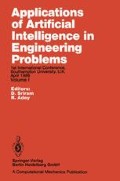Abstract
When fuzzy sets are used to model fuzzy information, the,analysis involves extended algebraic operations, i.e., operations on fuzzy numbers. The computational aspect of fuzzy information processing is addressed in this paper. In particular, a technique based on the α-cut representation of fuzzy sets and combinatorial interval analysis is presented. The method provides a discrete but exact solution to extended operations in a very efficient and simple manner, thus greatly expediting computer processing of fuzzy information in engineering. An example in risk assessment is given as illustration. The role of fuzzy information processing in expert systems is described.
Access this chapter
Tax calculation will be finalised at checkout
Purchases are for personal use only
Preview
Unable to display preview. Download preview PDF.
References
Baas, S. and Kwakernaak, H. (1979) Rating and Ranking of Multiple Aspect Alternatives Using Fuzzy Sets. Automatica, 13.
Brown, C. B. and Yao, J. T. P. (1983) Fuzzy Sets and Structural Engineering. ASCE J. Struct. Eng., 109, ST5.
Dong, W., Shah, H. C. and Wong, F. S. (1985) Fuzzy Computations in Risk and Decision Analysis. Submitted to Civil Engineering Systems.
Dong, W. and Wong, F. S. (1985) The Vertex Method and its Use in Earthquake Engineering. First Int. Symp. on Fuzzy Math, in Earthq. Research, Seismology Press, China.
Dubois, D. and Prade, H. (1980) Fuzzy Sets and Systems: Theory and Applications. Academic Press, New York.
Moore, R. E. (1966) Interval Analysis. Prentice-Hall, New Jersey.
Mullarkey, P. W., Fenves, S. J. and Sangrey, D. A. (1985) CONE — An Expert System for Interpretation of Geotechnical Characterization Data from Cone Penetrometers, R-85–147, Dept. of Civil Engineering, Carnegie-Mellon University.
Schmucker, K. J. (1984) Fuzzy Sets, Natural Language Computations, and Risk Analysis. Computer Science Press, Potomac, Maryland.
Wong, F. S., Dong, W., Boissonnade, A. and Ross, T. J. (1986) Expert Opinions and Expert Systems. ASCE 9th Electronic Computations Conf., Birmingham, Alabama.
Zadeh, L. A. (1965) Fuzzy Sets. Information & Control, 8.
Zadeh, L. A. (1973) Outline of a New Approach to the Analysis of Complex Systems and Decision Processes. IEEE Trans. Sys. Man Cyb., SMC-3, No.l.
Author information
Authors and Affiliations
Editor information
Editors and Affiliations
Rights and permissions
Copyright information
© 1986 Springer-Verlag Berlin Heidelberg
About this paper
Cite this paper
Wong, F.S., Dong, W. (1986). Fuzzy Information Processing in Engineering Analysis. In: Sriram, D., Adey, R. (eds) Applications of Artificial Intelligence in Engineering Problems. Springer, Berlin, Heidelberg. https://doi.org/10.1007/978-3-662-21626-2_22
Download citation
DOI: https://doi.org/10.1007/978-3-662-21626-2_22
Publisher Name: Springer, Berlin, Heidelberg
Print ISBN: 978-3-662-21628-6
Online ISBN: 978-3-662-21626-2
eBook Packages: Springer Book Archive

